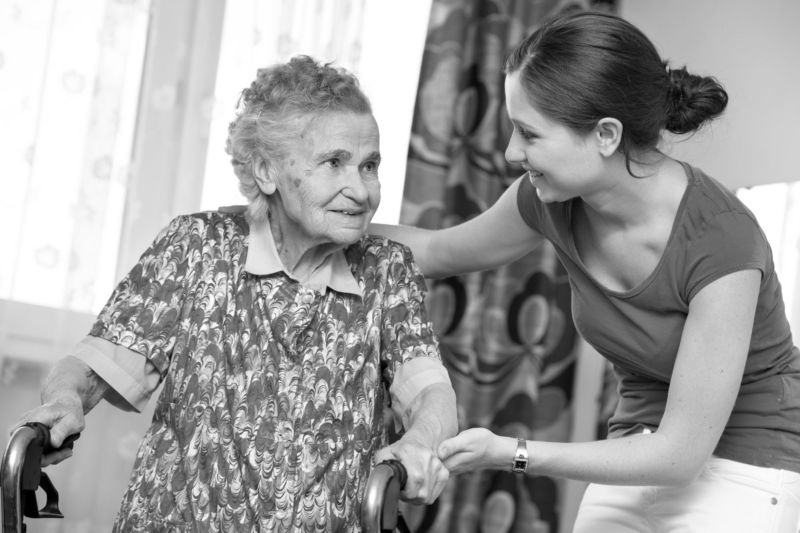A stroke, also known as a cerebrovascular accident, occurs when blood flow to the brain is blocked off and brain cells begin to die. The specific symptoms of a stroke depend on the part of the brain affected and how long the blood vessel blockage lasts. Sometimes a stroke victim recovers quickly, but in many cases, the brain damage becomes permanent and the patient loses the ability to complete everyday tasks. In the case of an acute stroke with long-term effects, hospice care may be warranted.
When to Seek Out Hospice Services for Stroke Patients
Since a stroke typically occurs without warning, family members may have to make a determination about hospice or palliative care quickly. A patient who’s had multiple minor strokes and experienced a decline in functional ability may want to consider hospice care before a major stroke occurs. Ongoing neurological damage from multiple strokes could lead to declining function over time.
Some people who’ve experienced a stroke also have another serious illness. Cardiovascular disease in particular often co-occurs with stroke. In some cases, a physician may make a hospice care referral for a related terminal illness, and the hospice team then manages symptoms of both conditions.
You can start the conversation about hospice care before you or your loved one meets the specific hospice criteria for patients who’ve had a stroke. Planning early makes the process easier once the patient is ready to enter hospice.


Fill out below to receive an informational diagnosis guide
Hospice Care Eligibility for Stroke Patients
A stroke is typically an acute event that damages brain tissue and causes an array of ongoing symptoms from that point forward. The severity of a stroke can vary. Some patients become completely debilitated by a stroke, while others may gradually recover some of the brain function lost during the stroke.
To enter hospice, a stroke patient must be evaluated by a doctor and determined to have a life expectancy of six months or less. Hospice care is intended for individuals who’ve ceased treatment for terminal illness. It’s aimed at alleviating symptoms and improving the patient’s quality of life. Some indicators that a patient may be hospice eligible after a stroke include:
- An inability to carry out personal grooming and household activities
- Progressive weight loss and an inability to maintain a reasonable caloric intake
- Being bed-bound or chair-bound most of the time
- A reduced level of consciousness or prolonged coma
- Unintelligible or barely intelligible speech that prevents the patient from articulating specific problems or needs
While hospice services are intended for individuals who’ve ceased curative treatment and have six months or less to live, some stroke victims may require extra care before reaching this point. Palliative care includes most of the same services as hospice, but it’s intended for those who wish to continue exploring their treatment options and have a longer expected life span than six months.
Three Oaks Hospice Locations
Three Oaks Hospice has locations across the U.S., ensuring that caring, compassionate hospice and palliative care are available to patients where they live. Three Oak Hospice provides on-site care in the home or where the patient calls home, whether that’s in their residence, a family member’s, or in a medical facility.
The Goal of Palliative and Hospice for Stroke Patients
Hospice and palliative care for stroke patients is primarily focused on symptom management and improving the quality of life. Hospice isn’t about giving up on living but on making the end stages of life as stress-free as possible. While curative treatment is discontinued before hospice care begins, the patient may still take medication or receive treatment for symptoms such as pain or breathing difficulties.
Some goals of hospice care include:
Accessing Hospice Care and Palliative Care
Stroke survivors can access palliative or hospice care at the place where they reside. Hospice and palliative care specialists can travel to the patient’s home, a family member’s home or an assisted living facility to provide services. In some cases, hospice services are available in the hospital during a temporary stay.
Hospice care helps patients spend their final weeks or months of life in a comfortable, familiar environment.
The Benefits of Hospice Care for Stroke Survivors and Their Families
Hospice care is coordinated between the patient, family and hospice care team. The exact services provided depend on the patient’s individual needs. Social workers on the hospice team help with care coordination. Some specific benefits of hospice care include:

Assistance With Everyday Tasks
Many stroke patients have trouble completing tasks such as personal grooming, moving throughout the home and feeding themselves. The hospice care team provides assistance with these activities of daily living so family caregivers can focus on spending quality time with their loved one.
Access to Health Care Professionals at Any Time
Nurses are an important part of the hospice or palliative care team, and skilled nursing care is available 24/7 when a patient is enrolled in hospice. Hospice nurses help with symptom management, such as managing pain medication. The hospice care team also provides medical supplies and equipment for terminally ill patients.
Some people require physical therapy after an acute stroke, and the hospice team may include physical and occupational therapists to help patients who require help with muscle activity.


Help With Emotional and Spiritual Concerns
Hospice services also typically include access to counselors and spiritual advisers who provide assistance navigating common mental, emotional and spiritual concerns at the end of life. Hospice volunteers provide companionship and help tackle errands or household tasks to relieve stress on the patient and family. Clergy members on the hospice team are available to discuss concepts surrounding death and religious concerns.
Bereavement counseling is another benefit available to families of hospice patients. Three Oaks Hospice offers up to 13 months of bereavement counseling and support after the patient’s death.
Accessing Hospice Care and Palliative Care
Hospice services and palliative medicine are typically covered by Medicare, Medicaid and some private insurance plans. The social worker assigned to your case can help you manage the paperwork involved with insurance coverage and ensure you get the services you need.
If you or your loved one has survived a stroke and would like to learn more about hospice services, contact Three Oaks Hospice using the form above, or find a convenient location near you.







